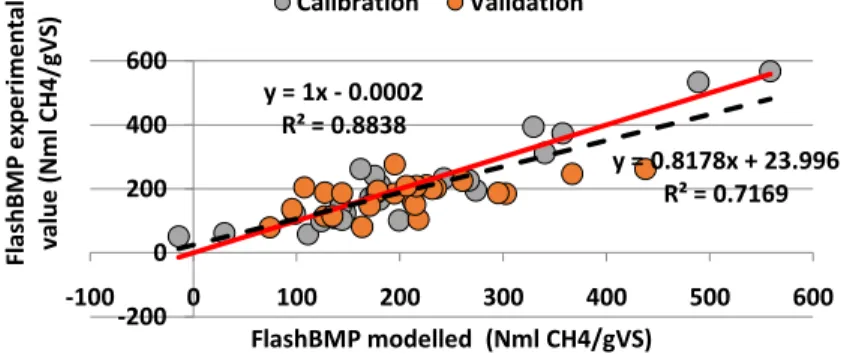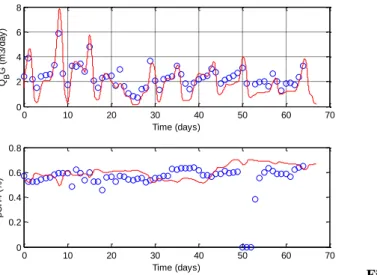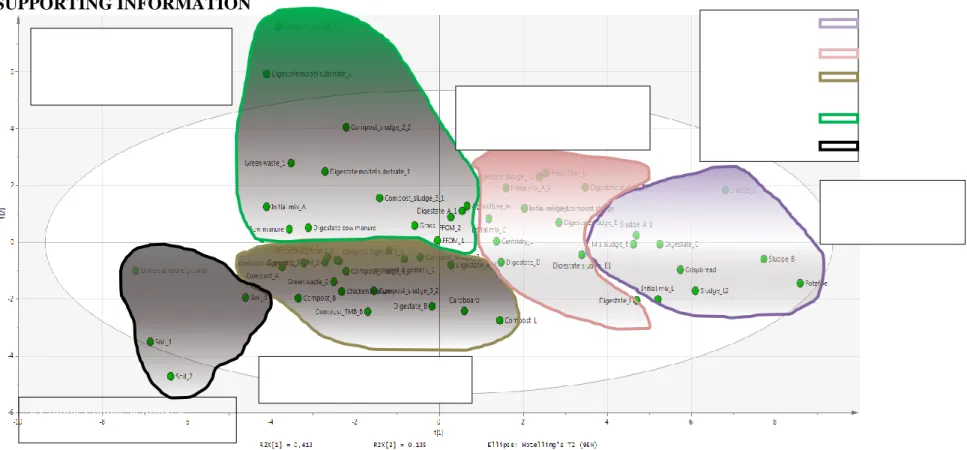HAL Id: hal-02743262
https://hal.inrae.fr/hal-02743262
Submitted on 3 Jun 2020
HAL is a multi-disciplinary open access archive for the deposit and dissemination of sci-entific research documents, whether they are pub-lished or not. The documents may come from teaching and research institutions in France or abroad, or from public or private research centers.
L’archive ouverte pluridisciplinaire HAL, est destinée au dépôt et à la diffusion de documents scientifiques de niveau recherche, publiés ou non, émanant des établissements d’enseignement et de recherche français ou étrangers, des laboratoires publics ou privés.
Organic matter characterization: towards a unified
methodology for biological treatments modelling
Julie Jimenez, Camila Espinoza Cavajal, Quentin Aemig, Sabine Houot,
Jean-Philippe Steyer, Fabien Vedrenne, Dominique Patureau
To cite this version:
Julie Jimenez, Camila Espinoza Cavajal, Quentin Aemig, Sabine Houot, Jean-Philippe Steyer, et al.. Organic matter characterization: towards a unified methodology for biological treatments modelling. 14. World Congress on Anaerobic Digestion (AD14), International Water Association (IWA). INT., Nov 2015, Viña del Mar, Chile. �hal-02743262�
Organic
matter
characterization:
towards
a
unified
methodology for biological treatments modelling
J. Jimenez*, C. Espinoza*, Q. Aemig*, **, S. Houot**, J.-P. Steyer*, F. Vedrenne*** and D. Patureau*
* INRA, UR0050, Laboratory of Environment Biotechnology, Av des Etangs, Narbonne, F-11100, France (E-mail: julie.jimenez@supagro.inra.fr)
** INRA UMR INRA-AgroParisTech Environment and Arable Crops, 78 850 Thiverval-Grignon, France ***VEOLIA Reseach and Innovation, Chemin de la digue, 78603 Maisons Laffitte, France
Abstract
The present study is an extension of the promising work performed by Jimenez et al. (2014). They developed an organic matter characterization methodology based on 3D fluorescence spectroscopy and chemical extractions. The objective was to predict both biodegradability and bioaccessibility to characterize the anaerobic digestion model input variables but only focused on municipal sludge. In this study, the protocol was extended to a larger spectrum of organic wastes and modified to better account for this diversity of organic residues. Accordingly, the ADM1 dynamic model has been modified with new input variables coming from this new methodology.
Keywords
Anaerobic digestion, modelling, biodegradability, bioaccessibility, 3D fluorescence
INTRODUCTION
In a context of environmental biorefinery, there is currently only few studies focused on both optimization of energetic valorization (by anaerobic digestion) and agronomical valorization of organic wastes (after or not composting). One way to achieve both objectives is process modelling. However, input variables from existing models are different (Jimenez et al., 2014; Zhang et al., 2012) and there is a need to find relevant and common input variables to set-up a plant wide model of organic matter of wastes, from the biological treatments to land spreading. In the recent years, a new promising methodology - the three dimensional fluorescence spectroscopy combined with organic matter fractionation by chemical extractions- has been successfully used to predict anaerobic biodegradability and bioaccessibility of municipal sludge (Jimenez et al., 2014). This study is an extension of this previous work: the application of this methodology to a wider range of organic wastes and the modification of the anaerobic digestion model input variables for a plant wide organic wastes treatment objective.
MATERIAL AND METHODS Biochemical methane potential test
To test the potential of the new protocol set up, anaerobic biodegradability of 58 organic wastes samples were measured through the Flash BMP® test, commercialized by Ondalys, and based on an instantaneous optical measurement of Near-Infrared Spectroscopy (NIRS) (Lesteur et al., 2011). The equivalent biochemical methane potential (BMP) is obtained from a Partial Least Square model in Nml CH4.gVS-1.
Chemical sequential extractions
The new extraction protocol was based on (Jimenez et al., 2014) with some modifications such as the addition of the acid extraction from Van Soest protocol (Van Soest, 1963). After drying and grinding (1mm) the sample, sequential extractions (30 mL) are performed on 0.5g of the dried sample. The obtained fractions are: (1) Soluble Extractible Organic Matter (SPOM) (milli-Q water solution containing 10mM of CaCl2, 15 min, 30°C, 300 rpm) (2) Readily Extractible Organic Matter (REOM) (saline basic extraction 10mM, 15min, 30°C, 300 rpm) (3) Slowly Extractible Organic Matter (SEOM) ( NaOH 0.1 M, 4 h, 30°C,300 rpm), (4) Poorly Extractible Organic Matter
(PEOM) obtained by 2 sequential acid extractions (25 mL H2SO4, 72%, 3 h, 30°C, 300 rpm). Results are expressed in COD (gO2.gTS-1).
Fluorescence spectroscopy analysis
The fluorescence spectrometer used was a Perkin Elmer LS55. Excitation wavelengths varied from 200 to 600 nm with increments of 10 nm. Fluorescence values were recorded every 0.5 nm between 200 and 600 nm. Based Jimenez et al. (2014), spectra were decomposed on seven zones corresponding on biochemical families-like fluorescence. The proportion of fluorescence of a zone “i” Pf i was calculated from the fluorescence zone volumes.
RESULTS
Accessibility characterization: new protocol
Fractionation protocol and 3D fluorescence spectroscopy were applied on 58 samples of organic wastes of different origins to cover the whole spectrum of applications (municipal wastes:3, municipal sludge:7, green wastes: 9, composts:16, manure: 2; digestate: 12, crop soils:3), . Using 33 variables composed of the 5 fractions (% in COD of SPOM, REOM, SEOM, PEOM and NEOM) and of the 4*7 fluorescence percentages Pf(i) corresponding to the 7 fluorescence zones of each extracts (SPOM, REOM, SEOM and PEOM), a principal component analysis was performed. The first component describes the complexity of the molecules (quality of the extracted COD) whereas the second one describes the accessibility of the molecules (quantity of the extracted COD), the two revealing 5 groups. Results are presented in the Figures A.1 from the supporting information. The variables induced by the combination of fractionation and 3D fluorescence spectroscopy are discriminant enough to classify the different nature of organic waste. The addition of acid extraction allows to extract between 60 and 90% of COD and to characterize not only sludge but also composts, green wastes, biowastes and soils.
Biodegradability characterization: prediction model
In order to go further and to validate the ability of these data to predict the biodegradability, a Partial Least Square (PLS) regression is successfully performed on 25 samples and then 25 samples are used for validation. The X-variables used are the same than in the (Jimenez et al., 2014) work. 28 variables are used and are the combination of the four fractions 𝑭𝒓𝒂𝒄𝒕𝒛𝒐𝒏𝒆 𝒊 = 𝑽𝑰𝑰𝒊=𝟏𝑷𝒇(𝒊) × 𝑭𝒓𝒂𝒄𝒕 (%COD) (i.e. SPOM, REOM, SEOM and PEOM) with the 7 fluorescence percentage zones. Y-variable is the BMP value obtained with the FlashBMP® test.
Figure 1. Correlation between modelled FlashBMP® values obtained with PLS and the experimental values
The PLS regression showed that there is a good correlation between the X and Y variables, with a R²Y value of 0.89 (Figure 1). Only three components are enough to describe 58% of X-variables and 89% of Y-variable. RMSE value was 47 NmlCH4.gVS-1 and RMSEP was equal to 75 NmlCH4.gVS-1. The methodology is successfully modified and is relevant enough to predict anaerobic biodegradability of a wider range of organic wastes (i.e. protein-like,
ligno-cellulosic-y = 1x - 0.0002 R² = 0.8838 y = 0.8178x + 23.996 R² = 0.7169 -200 0 200 400 600 -100 0 100 200 300 400 500 600 Fl ash BM P e xp e ri me n tal val u e ( N ml C H 4/ gV S) FlashBMP modelled (Nml CH4/gVS) Calibration Validation
like, biowastes, composts).
Modified ADM1: modifications of input variables
Using the modified Anaerobic Digestion model n°1 (ADM1) and data from Jimenez et al. (2014), calibration and validation of a lab scale mesophilic continuous reactors are performed. Input variables of the previously modified ADM1 are replaced by the fractionation simulating bioaccessibility (i.e. SPOM, REOM, SEOM as readily hydrolysable and PEOM and NEOM as slowly hydrolysable) and biodegradability is predicted by the PLS model. Acidogenesis biological process is simplified by considering only one soluble product (i.e. dissolved organic matter). Biological parameters are the same than the ones calibrated by Jimenez et al. (2014). Modified model can successfully predict anaerobic digestion of municipal sludge during organic matter or load perturbations as shown by the results from the Figure 2. Modifications of the model gave the same simulated results than the previous ADM1. Therefore, model was validated to be used for plant wide modelling.
Figure 2. Validation of the new modified model of
anaerobic digestion: biogas and methane production (red line: model; blue dot: experimental values)
CONCLUSIONS AND PERSPECTIVES
The new fractionation method developed has been successfully applied on a wider range of organic wastes. It allows characterizing the organic matter and predicts its biodegradability. Besides, the fractions extracted were used as input variables of ADM1 and model was modified for this purpose to obtain the same results than with the previous ADM1. The next step will be the implementation of a composting and soil models with the same input variables to optimize the plant wide treatment according both objectives of energetic and agronomical valorization.
ACKNOWLEDGEMENTS
The authors acknowledge ONEMA for funding support, Eric Latrille (INRA, Narbonne, France) and ONDALYS for the FlashBMP® set-up.
REFERENCES
Jimenez, J., Gonidec, E., Cacho Rivero, J.A., Latrille, E., Vedrenne, F., Steyer, J.-P., 2014. Prediction of anaerobic biodegradability and bioaccessibility of municipal sludge by coupling sequential extractions with fluorescence spectroscopy: towards ADM1 variables characterization. Water Res. 50, 359–72.
Lesteur, M., Latrille, E., Maurel, V.B., Roger, J.M., Gonzalez, C., Junqua, G., Steyer, J.P., 2011. First step towards a fast analytical method for the determination of Biochemical Methane Potential of solid wastes by near infrared spectroscopy. Bioresour. Technol. 102, 2280–8.
Van Soest, P.J., 1963. Use of detergents in the analysis of fibrous feeds. II. A rapid method for the determination of fiber and lignin.o Title. J.Ass.Offic.Agr.Chem 46, 829–835.
Zhang, Y., Lashermes, G., Houot, S., Doublet, J., Steyer, J.P., Zhu, Y.G., Barriuso, E., Garnier, P., 2012. Modelling of organic matter dynamics during the composting process. Waste Manag. 32, 19–30.
0 10 20 30 40 50 60 70 0 2 4 6 8 QB G ( m 3 /d a y ) Time (days) 0 10 20 30 40 50 60 70 0 0.2 0.4 0.6 0.8 p C H 4 ( % ) Time (days)
SUPPORTING INFORMATION
Figure A.1 : Correlation circles (scores) obtained from PCA analysis of all the samples studied for the 58 samples of organic wastes.
Sludge, carbohydrates Sludge Digestate Compost Green wastes/biowaste digestates Soils/fertile ground « Simple », accessible (SPOM/REOM/SEO M)
« Complex humic acid-like», poorly accessible (SEOM/PEOM)
« Complex-lignocellulose-like», moderately accessible
(SEOM/PEOM)
« Complex-lignocellulose-like», poorly accessible (PEOM/NEOM)
Intermediate complexity and accessibility (REOM/SEOM)


